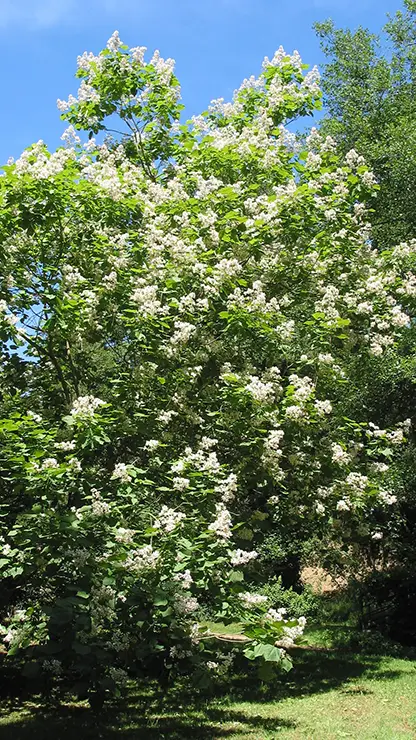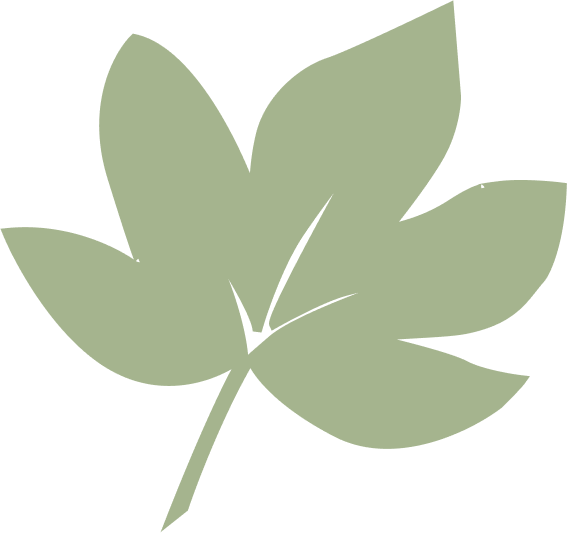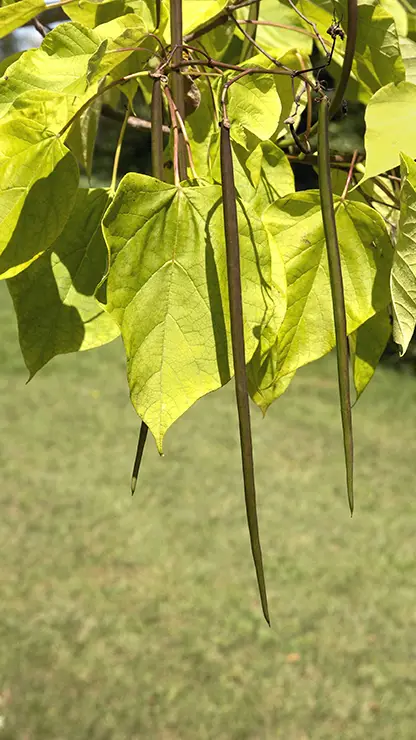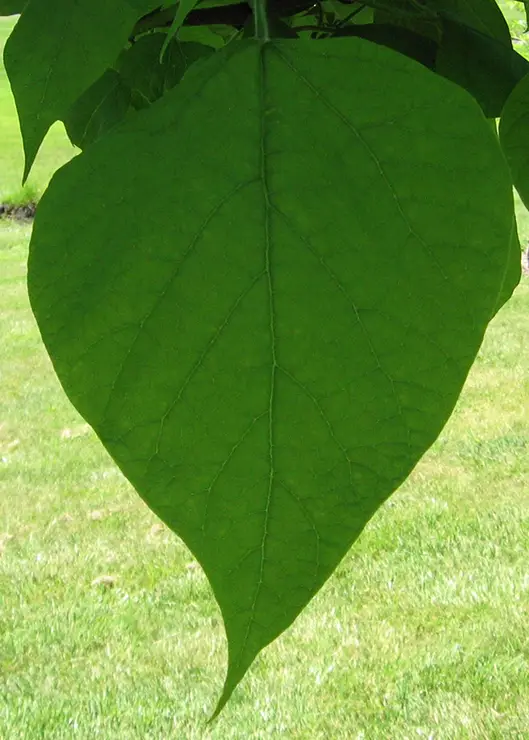

Western Catalpa
Catalpa speciosa Teas
Western Catalpa
Catalpa speciosa Teas
“…seed pods can reach up to 24 inches… its common name of “cigar tree”…”– Fun Facts
 Whole tree, Catalpa speciosa (Grandmont, 2011)
Whole tree, Catalpa speciosa (Grandmont, 2011)


Summary
Taxonomy
(How things are grouped and categorized based on shared traits.)- Kingdom: Plantae
- -Phylum: Streptophyta
- –Class: Equisetopsida
- —Subclass: Magnoliidae
- —-Order: Lamiales
- —–Family: Bignoniaceae
- ——Genus: Catalpa
- ——-Species: speciosa

Taxonomic History:
Catalpa speciosa is currently recognized as separate from Catalpa bignonioides, but some consider C. speciosa as a variety of C. bignonioides. (Kirkbride & Olsen, 2011).



Identification Tips
Catalpa speciosa resembles the Southern Catalpa, Catalpa bignonioides. Overall, the Western Catalpa is larger is all aspects: tree height, flower width, leave size, pod length and pod width (being 8-10(-15) mm wide) as compared to C. bignonioides (6-10 mm wide). Catalpa bignonioides’ leaves are abruptly acuminate (tapering to a narrow tip), while Catalpa speciosa’s leaves are more long-pointed (long-acuminate) (Breen, 2024). The Western Catalpa is said to smell ‘green’ when the leaves are crushed whereas the Southern Catalpa smells nasty.

Fun Fact!
The bean-like seed pods can reach up to 24 inches in length and give the tree its common name of “cigar tree” (Geyer & Broyles 2005).

Fun Fact!
Despite their bean-like appearance, Western Catalpa is more closely related to the trumpet vine Campsis radicans than to beans in the Legume family (POWO, 2024).
Native Range:


Native

Introduced
Plant Ecology/Habitat
Prior to European settlement, C. speciosa was found natively in the Central Mississippi Valley Basin but was planted extensively by settlers across the Eastern USA for its wood, which is resistant to rot. Catalpa is a tree that hosts numerous insects and species of fungi (Geyers & Broyles, 2005). It grows in open, wet habitats and is a nectar source for bees, flies, and wasps (Taylor, 2013).

Economic or Ethnobotanical Uses
- The Western Catalpa was widely used and planted by early settlers for use as shade trees, fence posts, lumber, furniture, railroad ties, etc.
- It is said that pioneer doctors used the seeds and pods to treat respiratory ailments (Geyer & Broyles, 2005).
- Today, Catalpa is widely used as an ornamental and has gained the Royal Horticultural Society’s Award of Garden Merit (RHS, 2024).


Conservation Status
Western Catalpa is listed as ‘Apparently Secure’ in states where data has been taken (NatureServe, 2002).
Additional Resources

References

- Breen, P. (2024). Catalpa bignonioides. Landscape Plants | Oregon State University. [website]. https://landscapeplants.oregonstate.edu/plants/catalpa-bignonioides
- Geyer, W.A. & Broyles, P.J. (2005). Northern Catalpa. USDA NRCS Plant Fact Sheet. [website]. https://plants.usda.gov/DocumentLibrary/factsheet/pdf/fs_casp8.pdf
- Grandmont, J.-P. (2011). Catalpa speciosa. [Photograph]. Wikimedia Commons. https://commons.wikimedia.org/wiki/File:Catalpa_speciosa_JPG01a.jpg#file
- Guy, F. (2011). Northern Catalpa flowers 1. [Photograph]. Wikimedia Commons. https://commons.wikimedia.org/wiki/File:Northern_catalpa_flowers_1_%28CFS_Arb%29.JPG
- Jebulon. (2011). Leaves and fruits of Catalpa bignonioides. [Photograph]. Wikimedia Commons. https://commons.wikimedia.org/wiki/File:Catalpa_bignonioides_detail.jpg
- Kirkbride, J.H. & Olsen, R.T. (2011). Neotypification of Catalpa speciosa (Bignoniaceae). Taxon, 60(6): 1760-1763.
- NatureServe. (2024). NatureServe Network Biodiversity Conservation Status Data. https://explorer.natureserve.org/Taxon/ELEMENT_GLOBAL.2.145196/Catalpa_speciosa
- Plant Image Library (2017). Catalpa speciosa (Northern Catalpa). [Photograph]. Wikimedia Commons. https://commons.wikimedia.org/wiki/File:Catalpa_speciosa_%28Northern_Catapla%29_%2835433010526%29.jpg
- POWO (2024). Plants of the World Online. https://www.rhs.org.uk/plants/21380/i-catalpa-speciosa-i/details
- Stang, D. (2005) Catalpa speciosa. [Photograph]. Wikimedia Commons. https://commons.wikimedia.org/wiki/File:Catalpa_speciosa_7zz.jpg
- Taylor, D. (2013). U.S. Forest Service, Plant of the Week. [Website]. https://www.fs.usda.gov/wildflowers/plant-of-the-week/Catalpa-speciosa.shtml
- USDA-NRCS-NGCE & NPDT (2014). Distribution of Pinus ponderosa. Retrieved 17 Sept 2024, from USDA Plants database, https://plants.usda.gov/plant-profile/GLTR
- Wagner, M. (2006). Catalpa speciosa leaf. [Photograph]. Wikimedia Commons. https://commons.wikimedia.org/wiki/File:Catalpa_speciosa_leaf_20060624.jpg
